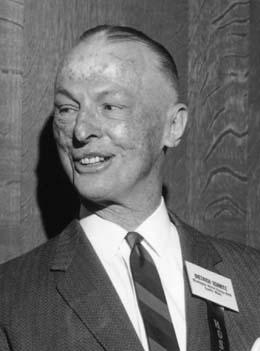Dietrich Schmitz was a Seattle banker and civic leader. The 65-year old "ramrod-straight, gentlemanly banker," as one business writer described him, was president of Washington Mutual Savings Bank. In addition to his financial contributions to the economy of the Pacific Northwest as banker and a meticulous bond specialist, he was a 25-year member of the Seattle School Board and served for 16 years on the Savings Bond program. For "his outstanding civic services and leadership in the economic, educational, and cultural life of his community" the Seattle-King County Association of Realtors named Dietrich Schmitz First Citizen of 1955.
West Seattle Boyhood
Schmitz was born in Seattle in 1890, son of immigrants Ferdinand and Emma Schmitz, who arrived from Germany in 1887 and set down roots in West Seattle's Alki district. Ferdinand was a banker and realtor. He acquired choice shore and timber-choked properties in the area, which contributed to a large, multi-acre family homestead. He was also involved in civic affairs, both as a city councilman in 1907, and with a seat on the Park Commission Board from 1908 to 1914.
Young Dietrich attended Seattle public schools. Before leaving Seattle for the University of Wisconsin to learn banking, he began his banking career when, at 17, he was hired as a messenger for the Union Savings and Trust Bank of Seattle. This early employment put him on the same professional path as his father.
Becoming a Banker
Upon his return to Seattle in 1916, Dietrich was hired by the Union National Bank. But World War I intervened, and he put in three years of naval service as an ensign and lieutenant junior grade. At the war's end, in 1921, he became a vice-president of the bank. His career then led him to the National Bank of Commerce (later, Rainier Bank), first as their bond-department manager, then as vice-president, and finally as director. He became President of Pacific National Bank in 1928.
In 1934 Schmitz was asked to take the reins of Washington Mutual Savings Bank, which was in steep decline as the Great Depression continued its devastating effects on the ability of the citizenry to save. Schmitz took over the institution at its lowest point; by year's end the turnaround had begun. At the time of his retirement in 1967 the bank had grown to 19 offices around the state with $605 million in deposits and more than 92,000 depositors. Today (2006) Washington Mutual Savings Bank is the third-largest mortgage lender in the United States and the ninth-largest credit-card company.
For the Community
Like his father before him, Schmitz was involved in civic affairs throughout his life, including charitable organizations. He is perhaps most widely known for his 31-year tenure as a member of the Seattle School Board (1930-1961), serving as its president eight times. He also served as King County chairman and state vice-chairman for the U.S. Savings Bond Committee, and held numerous posts as advisor to the Children's Orthopedic Hospital, the YMCA, the Seattle Historical Society, United Good Neighbors Fund, and the Seattle Foundation.
His banking experience made him ideally suited for the Boeing Company. He sat on the airplane manufacturer's board for 30 years during one of the largest growth spurts in the company's history.
Last Years and Legacy
In 1967, at the age of 77, Schmitz stepped down as chairman of the board of Washington Mutual Savings Bank and retired to his home on Beach Drive SW in the neighborhood where the family had resided since their arrival in Seattle 80 years earlier. He passed away in April 1970, leaving behind his wife Peggy, two daughters, and a son.
Today, although Dietrich himself is known primarily to local historians, the Schmitz family name continues to be recognized by Seattleites throughout the city. A large part of the family homestead acreage was turned over to the city by Ferdinand and Emma in 1908, which became the 40-acre timbered park known today as the Schmitz Preserve (Schmitz Park), in West Seattle.
Another gift to the city was land that became part of the site of today's Schmitz Park Elementary School. A 1,000-foot waterfront strip on Beach Drive, also part of the original Schmitz family homestead, is also a Seattle park, named in honor of Dietrich's mother, Emma. Finally, Dietrich's brother, Dr. Henry Schmitz (1892-1965), was president of the University of Washington from 1952 to 1958. The current administration building on the campus bears the younger sibling's name.

